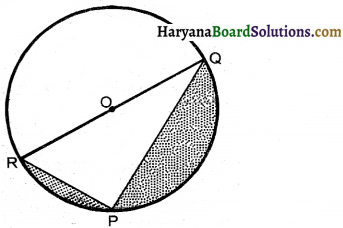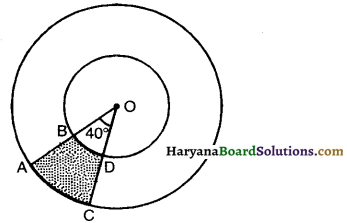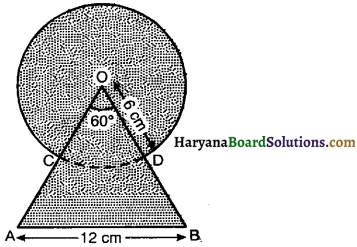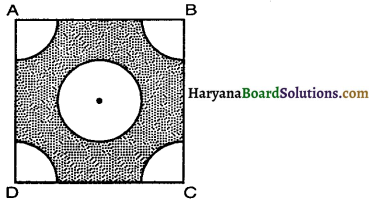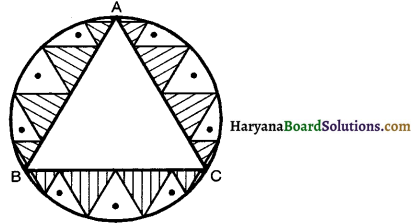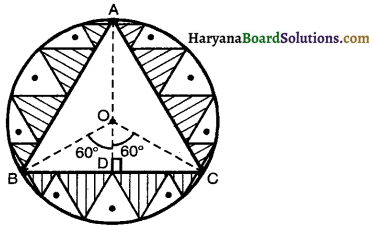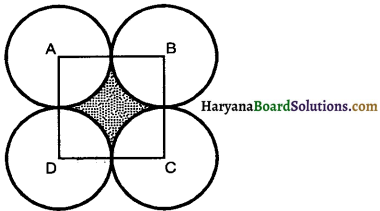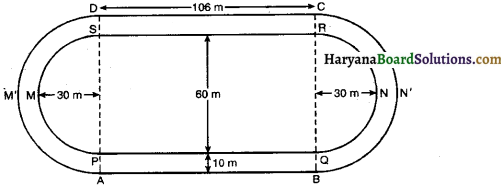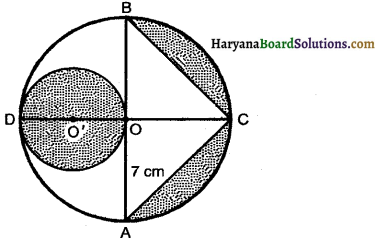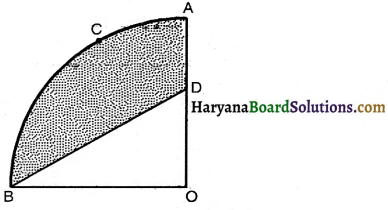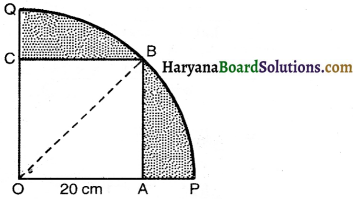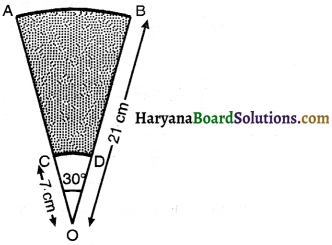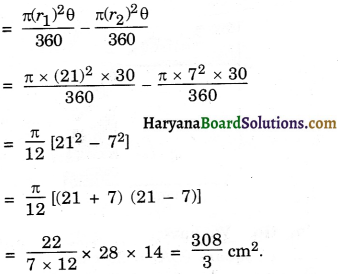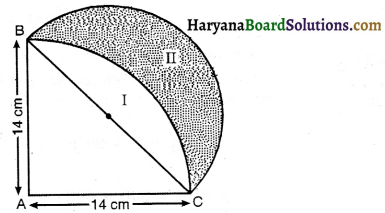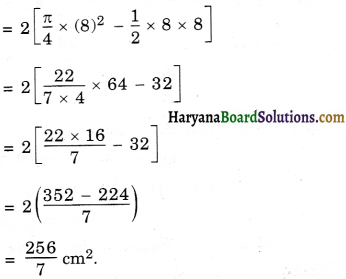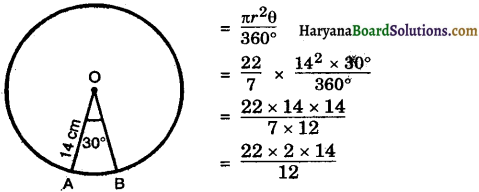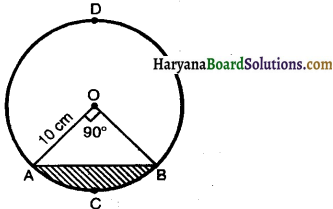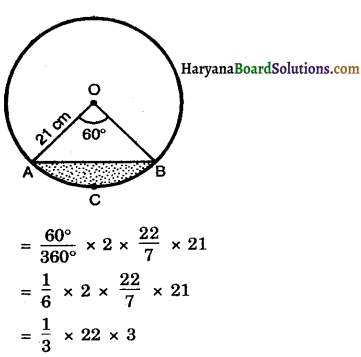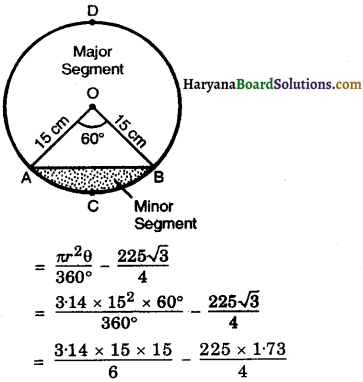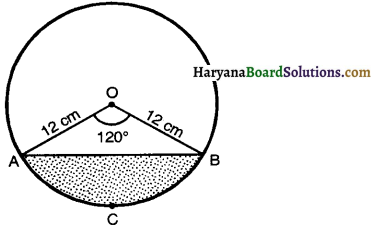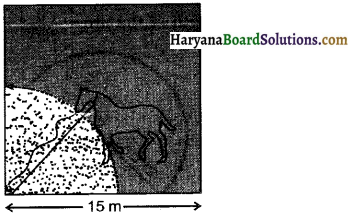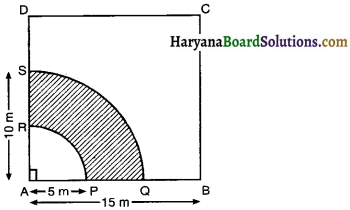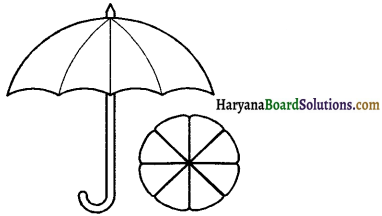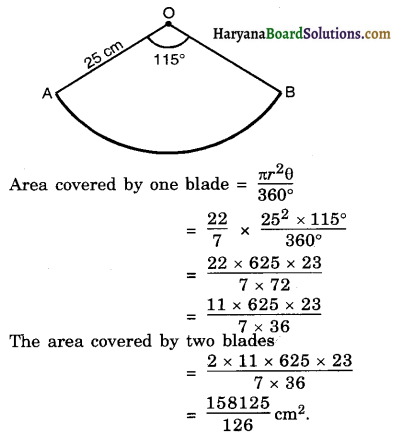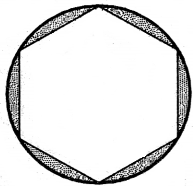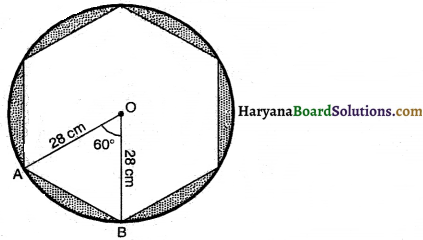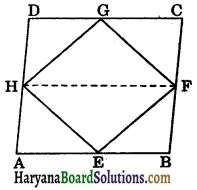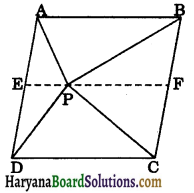Haryana State Board HBSE 8th Class Social Science Solutions Civics Chapter 1 भारतीय संविधान Textbook Exercise Questions and Answers.
Haryana Board 8th Class Social Science Solutions Civics Chapter 1 भारतीय संविधान
HBSE 8th Class Civics भारतीय संविधान Textbook Questions and Answers
भारतीय संविधान Chapter 1 HBSE 8th Class Civics प्रश्न 1.
किसी लोकतांत्रिक देश को संविधान की जरूरत क्यों पड़ती है?
उत्तर:
किसी लोकतांत्रिक देश को निम्नलिखित उद्देश्यों के लिए एक संविधान की आवश्यकता होती है:
(क) यह अपनी प्रस्तावना में राष्ट्रीय उद्देश्यों को लोगों के समक्ष रखता है जिन्हें ध्यान में रखकर सरकारों को कार्य करना होता है और इन उद्देश्यों से ही देश या समाज का स्वरूप कैसा होगा, इसकी भी जानकारी हमें संविधान से ही मिलती है।
(ख) प्रायः प्रत्येक देश में अनेक समुदायों के लोग रहते हैं। उनके सबके मिलने से ही राष्ट्र बनता है। वे कुछ ऐसे विश्वास रख सकते हैं जो जरूरी नहीं कि सभी लोगों या समुदायों को समान रूप से मान्य हों लेकिन संविधान सारे राष्ट्र के समक्ष ऐसे आदर्श एवं सिद्धांत रख सकता है जिन पर सभी लोग पर्याप्त सीमा तक पूर्णतया सहमत हों। उन्हें ध्यान से रखकर कानून बनाये जा सकते हैं तथा देश का शासन चलाया जा सकता है। इनमें सरकार संबंधी संस्थाएँ एवं कुछ आदर्श भी हो सकते हैं जिनके प्रति सभी लोग विश्वास रख सकते हैं कि देश में इनको पूर्णतया सुरक्षित रखा ही जाना चाहिए।
(ग) संविधान का एक अन्य उद्देश्य है-देश की राजनीतिक प्रणाली के स्वरूप को परिभाषित करना। जिन देशों में लोकतांत्रिक राज्यव्यवस्था को अपनाया गया है उनमें एक लिखित संविधान सरकार का पथ प्रदर्शन करता है। उनके निर्णय में संविधान महत्त्वपूर्ण भूमिका निभाता है। संविधान प्रतिनिधियों अथवा निर्वाचित सदस्यों के मनमाने व्यवहार पर नियंत्रण में महत्त्वपूर्ण भूमिका निभाता है। वे अपने अधिकारों का दुरुपयोग नहीं कर सकते हैं।
(घ) संविधान नागरिकों को कुछ मूलभूत अधिकार तथा कुछ मौलिक कर्तव्य प्रदान करता है।
(ङ) अंत में, संविधान का एक महत्त्वपूर्ण कार्य यह है कि यह कुछ ऐसी परिस्थितियाँ लोकतंत्र में सुनिश्चित करता है जिनकी वजह से ही अधिक शक्तिशाली लोग या समूह कम शक्तिशाली लोगों या समूह के विरुद्ध शक्ति का प्रयोग उनके खिलाफ नहीं कर सकते।

Chapter 1 HBSE 8th Class Civics प्रश्न 2.
नीचे दिए गए दो दस्तावेजों के हिस्सों को देखिए। पहला कॉलम 1990 के नेपाली संविधान का है। दूसरा कॉलम नेपाल के ताणा अंतरिम संविधान में से लिया गया है।
1990 नेपाल का संविधान
भाग-7: कार्यपालिका | 2007 अंतरिम संविधान भाग-5: कार्यपालिका |
| अनुच्छेद 35: कार्यकारी शक्तियाँ: नेपाल अधिराज्य की कार्यकारी नेपाल की कार्यकारी शक्तियाँ मंत्रिमंडल में निहित होंगी। | शक्तियाँ महामहिम नरेश एवं मंत्रिपरिषद् में निहित होंगी। नेपाल के कार्यकारी फैसले प्रधानमंत्री के नाम लिए जाएंगे। |
नेपाल के इन दोनों संविधानी में ‘कार्यकारी शक्ति’ के उपयोग में क्या फर्क विखाई देता है? इस बात को ध्यान में रखते हुए, क्या आपको लगता है कि नेपाल को एक नए संविधान की जरूरत है? क्यों?
उत्तर:
अंतर:
नेपाल के सन् 1990 के संविधान के भाग-7 के अनुच्छेद 35 के अनुसार उस देश में सभी कार्यपालिका संबंधी अधिकारों का प्रयोग करने का अंतिम अधिकार वहाँ के राजा (या राजशाही) के ही पास है। वह चाहे उनका जिस ढंग से प्रयोग करना चाहे, पूर्णतया अंतिम रूप से स्वतंत्र है। दूसरी तरफ नेपाल के अंतरिम संविधान (भाग-5 कार्यपालिका) के अनुसार नेपाल में कार्यकारिणी शक्तियों का प्रयोग मंत्रिपरिषद के द्वारा ही किया जाएगा। इसका अभिप्राय है कि नेपाल में संसदीय लोकतंत्र कार्य करेगा। उस देश के सभी कार्यकारी फैसले प्रधानमंत्री के नाम से ही लिए जाएंगे। (मंत्रिपरिषद नेपाल की संसद के प्रति उत्तरदायी होगी।)
उपर्युक्त विवरणों को ध्यान में रखते हुए सर्वप्रथम मैं कह सकता हूँ कि नेपाल में नये संविधान की जरूरत इसलिए है ताकि उस देश में यह लिखित रूप से तय किया जा सके कि भविष्य में नेपाल के राजा (राजतंत्र) की क्या स्थिति होगी तथा सरकार के तीनों अंगों का स्वरूप एवं कर्त्तव्य क्या-क्या होंगे (अर्थात् भविष्य में नेपाल में विधायिका, कार्यपालिका एवं न्यायपालिका का अपासी संबंध कैसा होगा?)।
इसके अतिरिक्त नये संविधान में स्पष्ट रूप से नागरिकों के क्या-क्या मौलिक अधिकार एवं कर्तव्य होंगे तथा उस देश या समाज के समक्ष कौन-कौन से आदर्श होंगे जिन्हें ध्यान में रखकर ही भविष्य में सरकार कार्य करेगी।
HBSE 8th Class Civics Chapter 1 भारतीय संविधान प्रश्न 3.
अगर निर्वाचित प्रतिनिधियों की शक्ति पर कोई अंकुश न होता तो क्या होता?
उत्तर:
यदि निर्वाचित प्रतिनिधियों की शक्ति पर किसी भी तरह की पाबंदी या अंकुश न हो तो वे (पूर्णतया संभावना थी) अपनी शक्तियों का दुरुपयोग करते या मनमाने ढंग से शासन करते। उन्हें जनमत को भी परवाह नहीं होती। लोकतंत्र में प्राय: संविधान नागरिकों को कई तरह से सरंक्षण प्रदान करता है। संविधान सर्वोच्च होता है। जनप्रतिनिधि अपनी मनमर्जी से (स्वेच्छाचारी ढंग से) अपनी स्थिति एवं शक्तियों का दुरुपयोग नहीं कर सकते। यदि उन्हें सत्ता के दुरुपयोग की छट मिल जाये तो उसका परिणाम बहुत ही अनर्थकारी हो सकता है।
प्रश्न 4.
निम्नलिखित स्थितियों में अल्पसंख्यक कौन हैं? इन स्थितियों का एक-एक कारण बताइए कि अल्पसंख्यकों के विचारों का सम्मान करना क्यों महत्त्वपूर्ण है।
(क) एक स्कूल में 30 शिक्षक हैं और उनमें से 20 पुरुष हैं।
(ख) एक शहर में 5 प्रतिशत लोग बौद्ध धर्म को मानते हैं।
(ग) एक कारखाने के भोजनालय में 80 प्रतिशत कर्मचारी शाकाहारी हैं।
(घ) 50 विद्यार्थियों की कक्षा में 40 विद्यार्थी संपन्न परिवारों से हैं।
उत्तर:
(क) प्रथम स्थिति में महिला अध्यापिकाएं अल्पसंख्यक है:
पुरुष अध्यापकों को महिला (नारी) अध्यापिकाओं के दृष्टिकोण का सम्मान करना चाहिए क्योंकि उनकी संख्या पुरुष अध्यापकों की अपेक्षा कम है। महिला अध्यापिकाओं को नियमित रूप से विद्यालय के अतिरिक्त अपने-अपने घरों पर अनेक कार्यों का उत्तरदायित्व भी निभाना पड़ता है। उन्हें अपने बच्चों, पति एवं ससुराल वालों (ससुर तथा सास) की भी देखभाल करनी पड़ती है।
इसके अतिरिक्त भारत एक ऐसा राष्ट्र है जहाँ प्राचीन काल से ही नारियों की (बहुसंख्या में) प्रायः पूजा की जाती रही है। (हर देवता के साथ देवी का नाम आता है। याद रहे पहले देवी का नाम फिर देवता का नाम सीता-राम, राधा-कृष्णा, गौरी-शंकर आदि) यहाँ तक कि पश्चिमी संस्कृति के दृष्टिकोण से भी कहा जाता हैमहिलाएं सबसे पहले (Ladies First) । अब तो हम 21वीं शताब्दी में रह रहे हैं। हमें पुरुष प्रधान अवधारणा को पूर्णतया त्याग देना चाहिए। संस्कृत के प्राचीन धार्मिक ग्रंथों में भी कहा गया है कि जहाँ नारियों का सम्मान होता है, वहाँ देवता वास करते हैं।
(ख) दूसरी स्थिति (या परिस्थिति) में बौद्ध अल्पसंख्यक हैं। अन्य धर्मों के लोग शहर में 95 प्रतिशत हैं। हम सभी जानते हैं कि अधिकांश बौद्ध शांति एवं अहिंसा प्रिय होते हैं। हमारा राष्ट्र धर्मनिरपेक्ष (पंथ निरपेक्ष) राष्ट्र है और हमारे देश का संविधान सभी अल्पसंख्यकों देश में पूर्ण आदर के साथ रहने की पूर्णतया समानता एवं स्वतंत्रता प्रदान करता है। इसके साथ ही साथ संविधान इस बात का भी पक्का विश्वास दिलाता है कि अल्पसंख्यकों को पूर्णतया शारीरिक, भावनात्मक एवं धार्मिक सुरक्षा प्राप्त होगी। बहुसंख्यक लोगों का अल्पसंख्यक लोगों के प्रति प्रेम भाव नि:संदेह दोनों संप्रदायों को परस्पर समीप लायेगा तथा यह परिस्थिति राष्ट्रीय एकता को सुदृढ़ता प्रदान करेगी।
(ग) इस स्थिति में मांसाहारी (गैर-शाकाहारी) अल्पसंख्या में हैं। प्रत्येक व्यक्ति (स्त्री अथवा पुरुष) अपनी पसंद के ही पकवान पसंद करते हैं। कारखाने के भोजनालय में प्रतिदिन 20 प्रतिशत माँसाहारी लोगों की पसंद का खाना तैयार किया जाना चाहिए। ऐसा स्वास्थ्यपूर्ण वातावरण दोनों तरह के भोजनकर्ताओं (अर्थात् शाकाहारी एवं मांसाहारी लोगों में) परस्पर प्रेम एवं विश्वास पैदा करेगा। भारतीयों के जीवन का अभिन्न अंग अनेकता में एकता है। एक कारखाने के रसोईघर या भोजनालय का प्रबंध (management) माँसाहारियों तथा शाकाहारियों के लिए पृथक-पृथक खाने की मॅजे या कक्ष अथवा उचित स्थानों की व्यवस्था कर सकता है।
(घ) लगभग 20 प्रतिशत विद्यार्थी तुलनात्मक रूप से (शेष 80 प्रतिशत विद्यार्थियों की अपेक्षा) अधिक निर्धन हैं। उनके पास तुलनात्मक रूप से कम आर्थिक सुविधाएँ उपलब्ध हैं। बहुसंख्यक (संपन्न) विद्यार्थी उनकी अपेक्षा अधिक भाग्यशाली हैं। उन्हें और शिष्ट व्यवहार एवं सकारात्मक दृष्टिकोण अपने कक्षा के निर्धन या साधन अभाव विद्यार्थियों के प्रति रखना चाहिए। यदि वे ऐसा करते हैं तो अपेक्षाकृत निर्धन या साधनहीन विद्यार्थियों में कभी भी हीन भावना विकसित नहीं होगी। अल्पसंख्यक समुदाय से जुड़े विद्यार्थियों के लिए और भी अधिक श्रेष्ठ अध्ययन वातावरण होगा तथा वे स्वयं को अधिक एवं सामाजिक दृष्टि से दुर्बल नहीं समझेंगे।

प्रश्न 5.
नीचे दिए गए बाएँ कॉलम में भारतीय संविधान के मुख्य आयामों की सूची दी गई है। दूसरे कॉलम में प्रत्येक आयाम के सामने दो वाक्यों में लिखिए कि आपकी राय में यह आयाम क्यों महत्त्वपूर्ण है।
| मुख्य आयाम | महत्त्व |
| संघवाद | |
| शक्तियों का बँटवारा | |
| मौलिक अधिकार | |
| संसदीय शासन पद्धति | |
उत्तर:
संघवाद (Federalism):
1. यह आयाम इस बात की ओर संकेत देता है कि देश में एक से ज्यादा स्तरों पर सरकार पायी जाती है। भारत में हमारी दो तरह की सरकारें हैं-केन्द्र स्तर की तथा राज्य स्तर की। पंचायती राज तीसरे स्तर की सरकार है।
2. भारत में अनेक समुदायों के पाये जाने का अभिप्राय है कि एक ऐसे ढंग की सरकार अपनाना है जिसमें केवल वे ही लोग शामिल न हों जो देश की राजधानी शहर नई दिल्ली में ही बैठकर हर एक के लिए निर्णय लें। इसकी बजाय, यह अधिक महत्त्वपूर्ण था कि राज्य स्तरों पर अलग-अलग सरकारें कार्यरत हों जो न विशेष क्षेत्रों के लिए निर्णय ले सकें।
3. भारत में प्रत्येक राज्य में कुछ मामलों में राज्य सरकारों को स्वायत्तता प्राप्त है लेकिन कुछ विषय ऐसे हैं जो राष्ट्र से संबंधित हैं और उस संबंध में सभी राज्य केन्द्रीय सरकार के नियमों का अनुसरण करते हैं। संविधान में विषयों की कुछ सूचियाँ दी गयी हैं जिनमें यह स्पष्ट बताया गया है कि उन पर किस स्तर की सरकार कानून बना सकती है।
शक्तियों का बँटवारा (Separation of Powers):
भारत के संविधान के अनुसार राज्य के तीन अंग हैं। ये हैं-विधायिका, कार्यपालिका एवं न्यायपालिका।
(i) विधायिका हमारी संसद है जिसका गठन चुने हुए सदस्यों द्वारा होता है। राष्ट्रपति भी इसका एक सदस्य है।
(ii) कार्यपालिका (विधायिका की अपेक्षा) एक छोटे आकार का समूह होता है जो कि कानूनों को लागू करने एवं सरकार के चलाने के लिए उत्तरदायी है।
(iii) न्यायपालिका का तात्पर्य है इस देश में पायी जाने वाली न्यायिक व्यवस्था जिसके शीर्ष पर उच्चतम न्यायालय है।
मौलिक अधिकार (Fundamental Rights):
1. संविधान का वह हिस्सा जिसमें नागरिकों के मौलिक अधिकारों का उल्लेख होता है, उसे भारतीय संविधान की आत्मा कहा जाता है।
2. मौलिक अधिकार नागरिकों की रक्षा करते हैं तथा राज्य को मनमाने ढंग से शक्तियों के प्रयोग करने से रोकते हैं। इस तरह संविधान नागरिकों के अन्य व्यक्तियों से अधिकारों की सुरक्षा देने के आश्वासन देने के साथ-साथ उसे राज्य के विरुद्ध भी संरक्षण प्रदान करने का यकीन देता है।
3. भारतीय संविधान में नागरिकों को जो मौलिक अधिकार दिए गए हैं, उनमें शामिल हैं: (0) समानता का अधिकार, (ii) स्वतंत्रता का अधिकार, (ii) धार्मिक स्वतंत्रता का अधिकार, (iv) शोषण के विरुद्ध अधिकार, (v) सांस्कृतिक एवं शैक्षणिक अधिकार, (vi) संवैधानिक उपचारों का अधिकार.
संसदीय शासन पद्धति (Parliamentary Form of Government):
1. विभिन्न स्तरों की सरकारों (केन्द्र, राज्य तथा स्थानीय) में वे लोग प्रतिनिधि के रूप में होते हैं जिन्हें लोगों के द्वारा चुना जाता है।
2. भारतीय संविधान सभी नागरिकों को समान रूप से सार्वभौमिक वयस्क मताधिकार की व्यवस्था करता है। संविधान सभा में कार्यरत लोगों ने, जब वे देश के लिए संविधान का निर्माण कर रहे थे, यह महसूस किया कि राष्ट्रीय स्वतंत्रता के लिए चलाए गए आंदोलन के दौरान यह उन्हें भलीभाँति ज्ञात हो गया था कि देश की जनता सार्वभौमिक वयस्क मताधिकार का उपयोग करने के लिए पूर्णतया समर्थ है। और ऐसी व्यवस्था देश में परंपरागत चली आ रही जाति, वर्ग एव लिंग के आधार पर भेदभावों को जोड़ देगी। इसका तात्पर्य यह था कि लोग अपने प्रतिनिधियों का चयन करने में प्रत्यक्ष रूप से सीधी भूमिका निभायेंगे।
3. देश का प्रत्येक नागरिक, बिना किसी जाति, रंग, लिंग, सामाजिक पृष्ठभूमि के चुनाव लड़ सकता है। ये प्रतिनिधि जनता के प्रति जवाबदेह होते हैं।

प्रश्न 6.
भारत के नक्शो में निम्नलिखित देशों पर रंग भरें:
(क) भारत को लाल रंग से भरें
(ख) नेपाल को हरे रंग से भरें
(ग) बांग्लादेश को पीले रंग से भरे।
उत्तर:
विधार्थी स्वयं करें।
HBSE 8th Class Civics भारतीय संविधान Important Questions and Answers
अति लघु उत्तरात्मक प्रश्न
प्रश्न 1.
संविधान क्या है?
उत्तर:
सरल भाषा में, हम कह सकते हैं किस संविधान कानूनों का एक समूह (समुच्चय = Set) होता है जिसके अनुसार किसी देश की सरकार चलायी जाती है। यह सरकार के तीनों अंगों की स्थितियाँ एवं अधिकार निर्धारित करता है (अर्थात् कार्यपालिका, विधायिका एवं न्यायपालिका की स्थितियाँ एवं शक्तियाँ निर्धारित करता है।) यही सरकार एवं नागरिकों के मध्य संबंधों की भी व्याख्या करता है।
प्रश्न 2.
प्रस्तावना की परिभाषा दीजिए।
उत्तर:
हमारे संविधान की भूमिका या प्राक्कथन को प्रस्तावना (Preamble) के नाम से जाना जाता है। यह प्रस्तावना स्रोतों, उद्देश्यों एवं हमारे संविधान के अंदर निहित आत्मा की ओर संकेत देती है।
प्रश्न 3.
हमारे (संविधान की) प्रस्तावना में जो विभिन्न उद्देश्यों को दिया गया है, वे क्या-क्या हैं?
उत्तर:
इसमें जो प्रमुख उद्देश्य बताये गये हैं उनमें शामिल हैं-न्याय, स्वतंत्रता, समानता, भ्रातृत्व, व्यक्तिगत सम्मान, एकता एवं राष्ट्र की भावनात्मक अखंडता।
प्रश्न 4.
हमारे संविधान की कोई सी तीन प्रमुख विशेषताएँ दीजिए।
उत्तर:
भारतीय संविधान की तीन प्रमुख विशेषताएँ हैं:
(अ) यह भारत में सार्वभौमिक, समाजवादी, धर्मनिरपेक्ष, लोकतांत्रिक गणराज्य स्थापित करता है।
(ब) यह भारत के नागरिकों को मौलिक अधिकार प्रदान करता है तथा उन्हें उनके मौलिक कर्तव्य भी बताता है।
(स) संविधान ने देश में केन्द्र तथा सभी राज्यों के लिए भी संसदीय ढंग की सरकार को अपनाया है।
प्रश्न 5.
“राज्य के नीति निदेशक सिद्धांतों” पर एक
उत्तर:
भारतीय संविधान में राज्य के नीति निर्देशक सिद्धांत भी दिए गये हैं। ये सिद्धांत नैतिक रूप से दिशा निर्देशक सूचनाएँ या मार्गदर्शक हैं। विभिन्न सरकारों द्वारा इनके पालन करने की अपेक्षा की जाती है। संविधान समिति के विचार में यदि इन नीति निर्देशों को सच्चाई के साथ लागू किया गया तो भारत में एक सामाजिक कल्याणकारी राज्य की स्थापना हो जाएगी। ये नीति निर्देशक सिद्धांत उस मार्ग पर चलने का मार्ग दिखाते हैं जो भारत के लोगों को संविधान की प्रस्तावना में उल्लेखित सभी श्रेष्ठ आदर्शों को प्राप्त करने में सहायता देंगे-“न्याय अर्थात् सामाजिक, आर्थिक एवं राजनीतिक, स्वतंत्रता, समानता एवं भाईचारा।”

प्रश्न 6.
संक्षेप में “भारत में समाजवाद ” का वर्णन कीजिए।
उत्तर:
समाजवाद के अनुसार सरकार प्रत्येक वह कार्य करेगी जिससे लोगों की सामाजिक एवं आर्थिक प्रगति एवं कल्याण हो सके। देश के प्रत्येक नागरिक को जीवन में प्रगति के लिए समान अवसर दिया जायेगा।
प्रश्न 7.
संविधान सभा ने नीति निर्देशक सिद्धांतों को जोड़ने का निर्णय क्यों लिया था?
उत्तर:
मौलिक अधिकारों के साथ-साथ संविधान में एक भाग में नीति निर्देशक सिद्धांत भी दिए गए हैं। इस भाग को संविधान निर्माताओं के द्वारा इसलिए जोड़ा गया था ताकि सामाजिक और आर्थिक सुधारों को और अधिक अच्छे ढंग से सुनिश्चित किया जा सके। इसलिए भी निहित किये गये ताकि स्वतंत्र भारत में राज्य ऐसे कानून एवं नीतियाँ बनाये जिनसे सर्वसाधारण की निर्धनता को कम करने में सहायता मिल सके।
लघु उत्तरात्मक प्रश्न
प्रश्न 1.
भारतीय संविधान ने जिन अधिकारों को प्रतिभू (गारंटी दी है) किया है उन्हें मौलिक अधिकारों के रूप में क्यों जाना जाता है?
उत्तर:
संविधान में अधिकारों को इस आशा से शामिल किया गया था कि वे समाज में सामाजिक एवं राजनीतिक बदलाव लायेंगे। भाग तीन में संविधान का अनिवार्य (कोर-Core) भाग है जो मौलिक अधिकारों से संबंधित है। अधिकार वे शक्तियाँ एवं स्वतंत्रताएँ हैं जो व्यक्तिगत एवं सर्वजनों की सामान्य भलाई के लिए अति आवश्यक हैं एवं जिन्हें संविधान के अंतर्गत जमानत (या प्रतिभू, गारंटी) प्राप्त है। इन्हें मौलिक अधिकार कहा जाता है क्योंकि इन्हें देश के मूलभूत (मौलिक) कानूनों में शामिल किया गया है तथा इन्हें न्यायालय जबर्दस्ती लागू करा सकते हैं।
मौलिक अधिकारों को इसलिए मौलिक कहा जाता है कि नागरिकों को जब कभी भी अपने मौलिक अधिकारों के हनन होने का अंदेशा हो तो वे सर्वोच्च न्यायालय तथा उच्च न्यायालय का दरवाजा खटखटा सकते हैं। न्यायालयों को अधिकार तथा शक्ति प्राप्त है कि वे उनका (मौलिक अधिकारों का) यथाशीघ्र हनन रोक सकें।
ये अधिकार इसलिए भी मौलिक हैं क्योंकि सभी नागरिक इस स्थिति में हैं कि वे अपने कल्याण को पाने तथा अपने व्यक्तित्व के विकास हेतु दावा कर सके।
‘प्रश्न 2.
भारत के संविधान की प्रस्तावना की कोई-सी चार प्रमुख विशेषताएँ लिखिए।
उत्तर:
भारत के संविधान की प्रस्तावना की चार प्रमुख विशेषताएँ:
1. प्रस्तावना संविधान का एक प्रमुख भाग है क्योंकि इसमें संविधान का निचोड़ है।
2. प्रस्तावना संक्षेप में संविधान के सभी उद्देश्यों एवं लक्ष्यों को प्रतिबिंबित करती है। प्रस्तावना को संविधान का दर्पण कहना गलत नहीं होगा।
3. इसमें सरकार के प्रमुख अंगों-कार्यपालिका एवं न्यायपालिका के कार्यप्रणाली संबंधी सभी पहलुओं को दिया गया है।
4. प्रस्तावना संविधान के सभी प्रमुख सार तत्वों का ज्ञान प्रस्तुत करती है। वास्तव में प्रस्तावना, संविधान की नींव है। पूर्व-प्रमुख न्यायाधीश के सुब्बाराव के शब्दों में, ‘पूरे संविधान का सार तत्व प्रस्तावना में दिया गया है।’

प्रश्न 3.
प्रस्तावना का क्या महत्त्व है अथवा भारतीय संविधान के लिए प्रस्तावना की क्या महत्ता है?
उत्तर:
प्रस्तावना संविधान के लिए निम्न तरह से महत्त्वपूर्ण है:
1. इससे हमें पता लगता है संविधान का स्रोत कौन सा है अर्थात् यह प्रस्तावना इन शब्दों से शुरू होती है- हम, भारत के लोग। अर्थात् प्रस्तावना से ही पता चलता है कि स्वतंत्र भारत के लिए संविधान का निर्माण एक सभा ने किया था। इस सभा में उस समय के कानून विशेषज्ञ, महान नेता, सभी संप्रदायों, वर्गों, क्षेत्रों के प्रतिनिधि शामिल थे। इसका प्रारूप एक समिति द्वारा संविधान सभा के सामने रखा गया। संविधान के प्रत्येक भाग को अंतिम रूप देने के लिए इस पर खूब बहस हुई। परोक्ष रूप से स्वयं जनता ने सभाओं, गोष्ठियों, समाचारपत्रों आदि के द्वारा अपनी राय दी। उन पर बहस हुई तथा लगभग तीन वर्षों के बाद इस पर संविधान सभा के सदस्यों ने हस्ताक्षर करके यह बता दिया कि इसका मूलत: स्रोत देश की जनता ही है।
2. प्रस्तावना ही भारत (या राज्य) के स्वरूप के बारे में बताती है कि भारत एक सार्वभौमिक (पूर्ण सत्ता संपन्न). समाजवादी. धर्मनिरपेक्ष, लोकतांत्रिक गणराज्य है। भारत किसी भी तरह से किसी विदेशी शक्ति के अधीन नहीं है। यह देश में सर्वसाधारण के लिए कल्याणकारी सामाजिक-आर्थिक व्यवस्था (समाजवादी ढंग का समाज बनाने) लाने का प्रयास करेगा। यह पंथ या धर्म निरपेक्ष लोकतांत्रिक गणराज्य होगा। यहाँ के राष्ट्राध्यक्ष राष्ट्रपति का निर्वाचन परोक्ष रूप से जनता के प्रतिनिधि ही करते हैं। उसका पद वंशानुगत नहीं है। भारत एक संसदीय लोकतंत्र है जो सर्वप्रिय, लोकप्रिय तथा उदारतापूर्वक ढंग से काम करता है।
प्रश्न 4.
भारत को एक धर्म निरपेक्ष राज्य बनाने के लिए हमारे संविधान में क्या-क्या व्यवस्थाएँ की गयी हैं? संक्षेप में चर्चा कीजिए।
उत्तर:
भारत अनेक धर्मों की भूमि है। भारतीय संविधान में धर्मनिरपेक्षतावाद का तात्पर्य है कि देश के सभी धर्मों का समान सम्मान। यह सभी विश्वासों (संप्रदायों/समुदायों या धर्मो/पक्षों) को बिना किसी भय अथवा पक्ष के सभी को अपने धर्म के अनुसार पूजा या विश्वास (आस्था या संस्कार) रखने की अनुमति देता है। यह किसी भी नागरिक के साथ उसके विश्वास (आस्था/संस्कार) या धर्म के आधार पर किसी भी तरह का भेदभाव न करने का यकीन (गारंटी) देता है, चाहे उनका कोई भी धर्म हो। अपनी से ऊँचे पद पर आसीन हो सकते हैं। सरकार न तो किसी धर्म के प्रचार में किसी प्रकार का सहयोग देगी तथा न ही किसी तरह का अवरोधक खड़ा करेगी। कोई भी धर्मानुयायी देश के किसी भी भाग में रह सकता है।
प्रश्न 5.
राजनीतिक समानता का क्या अर्थ है?
उत्तर:
राजनीतिक समानता का अर्थ है कि देश के सभी नागरिकों के पास एक जैसे (समान रूप से) राजनीतिक अधिकर प्राप्त होने चाहिएँ और उनमें जाति, धर्म, रंग, लिंग अथवा क्षेत्र के आधार पर किसी भी तरह से भेदभाव नहीं किया जाना चाहिए। इसका अर्थ है सर्वव्यापी वयस्क मताधिकार और चुनाव लड़ने का अधिकार। सभी को सरकार के सभी पदों (योग्यतानुसार) एवं लोक कार्यालय तक पहुंचने का समान अधिकार एवं अवसर मिलने चाहिए।
प्रश्न 6.
संसदीय पद्धति से आप क्या समझते हैं?
उत्तर:
संसदीय पद्धति: भारतीय संविधान द्वारा केन्द्र तथा – सभी राज्यों में संसदीय ढंग की सरकारें बनाने की व्यवस्था की गयी है। इसका अर्थ है कि राज्यों में राज्य विधान सभा तथा केन्द्र में संसद विशेषकर लोकसभा सर्वोच्च है और वह ही कार्यकारिणी तथा राज्य या देश के वित्त पर नियंत्रण रखती है। राज्यों में मुख्य मंत्री सहित राज्य मंत्रिमंडल तथा केन्द्र में प्रधानमंत्री सहित केन्द्रीय मात्रमडल क्रमशः राज्य विधानमंडल (विशेषकर राज्य विधान सभा) तथा केन्द्रीय मंत्रिमंडल संसद (विशेषकर लोकसभा) के प्रति पूर्णतया उत्तरदायी है।

प्रश्न 7.
“समवर्ती सूची” पर एक संक्षिप्त नोट (टिप्पणी) लिखें।
उत्तर:
समवर्ती सूची (The Concurrent List):
इस सूची में जो कुल 47 विषय दिए गये हैं उन पर देश की संसद तथा राज्यों की विधायिका दोनों को ही कानून बनाने का अधिकार प्राप्त है। ये विषय केन्द्रीय तथा राज्य सरकारों दोनों से ही सामान्य रूप से संबंधित हैं। पर इसमें एक व्यवस्था यह भी है कि दोनों स्तरों की सरकारों द्वारा बनाये गये कानूनों में यदि कोई टकराव हो जाता है तो राज्य कानून की बजाय केन्द्रीय कानून ही प्रभावशाली होगा। इस सूची में दिए गये विषयों में से कुछ हैं-सिविल एवं फौजदारी मामले, शिक्षा, विवाह तथा तलाक आदि।
प्रश्न 8.
‘संप्रभुता संपन्न लोकतांत्रिक गणराज्य’ पर एक संक्षिप्त टिप्पणी लिखिए।
उत्तर:
संप्रभुता संपन्न लोकतांत्रिक गणराज्य (Sovereign Democratic Republic):
भारत के संविधान ने देश को पूर्णतया संप्रभुता संपन्न लोकतांत्रिक गणराज्य घोषित किया है जिसका तात्पर्य है कि भारत आंतरिक नीतियों, प्रशासनिक निर्णयों तथा बाह्य नीतियों एवं कार्यक्रम आदि तय करने के लिए पूर्णतया स्वतंत्र है। विश्व की कोई भी शक्ति या बड़े से बड़ा देश भी अपनी इच्छा भारत पर लाद नहीं सकता।
भारत में लोकतंत्रीय शासन प्रणाली को अपनाया गया। लोकतंत्र लोगों का, लोगों के द्वारा तथा लोगों के लिए राज्य होता है। देश की सर्वोच्च सत्ता नागरिकों या लोगों में निहित है। देश लोकतंत्र होने के साथ-साथ गणतंत्र है। देश का सर्वोच्च संवैधानिक प्रमुख राष्ट्रपति है। उसका पद वशानुगत नहीं है। उसका निर्वाचन हर पाच वर्ष के बाद चुने हुए सासद तथा राज्यों का विधानसभाओं के निर्वाचित सदस्य मिलकर एक निर्वाचक मंडल के रूप में करते हैं। यानी देश के राष्ट्राध्यक्ष (राष्ट्रपति) के निर्वाचन में देश की जनता अप्रत्यक्ष रूप से भाग लेती है।
प्रश्न 9.
धर्मनिरपेक्ष राज्य पर एक टिप्पणी लिखिए।
उत्तर:
धर्मनिरपेक्ष राज्य (Secular State) एक ऐसा राज्य होता है जिसमें राज्य का कोई धर्म नहीं होता। इसके अतिरिक्त राज्य किसी भी धर्म का विरोध नहीं करेगा। प्रत्येक नागरिक को धर्म की स्वतंत्रता के प्रति मौलिक अधिकार प्राप्त होगा। इसका तात्पर्य है कि प्रत्येक नागरिक को किसी भी धर्म को मानने की, उसका प्रचार करने की पूर्ण स्वतंत्रता होगी। वह किसी भी तरह से अपने धर्म गुरुओं अथवा देवी-देवताओं की अर्चना-पूजा या इबादत कर सकता है। उदाहरणार्थ भारत एक धर्मनिरपेक्ष राज्य है और भारत के प्रत्येक नागरिक को धर्म की पूर्ण स्वतंत्रता एवं समानता प्राप्त है।
प्रश्न 10.
‘कल्याणकारी राज्य’ पर एक टिप्पणी लिखिए।
उत्तर:
कल्याणकारी राज्य (Welfare State):
एक राज्य को तभी कल्याणकारी राज्य कहा जाता है जबकि वह नागरिकों के कल्याण के लिए बहुत सारा कार्य करे। ऐसे राज्य में, नीति निर्देशक सिद्धान्तों एवं नागरिकों के मौलिक अधिकारों को बहुत ही महत्त्व दिया जाता है। मौलिक अधिकारों के साथ-साथ मौलिक कर्तव्यों को भी शामिल किया जाता है। देश में कमजोर वर्गों जैसे अनुसूचित जातियों अनुसूचित जनजातियों, अन्य पिछड़ी जातियों, शैक्षिक एवं सामाजिक दृष्टि से पिछड़े लोगों, विकलांगों, महिलाओं एवं वरिष्ठ नागरिकों के लिए कई तरह की नीतियां बनायी जाती है, कार्यक्रम शुरू किये जाते हैं तथा समय-समय पर उन्हें सहायता एवं सहयोग संबंधी कार्यक्रमों की घोषणाएँ ही नहीं की जाती अपितु उन्हें लागू भी किया जाता है।

दीर्घ उत्तरात्मक प्रश्न
प्रश्न 1.
भारतीय संविधान की प्रमुख विशेषताओं का वर्णन कीजिए।
उत्तर:
भारतीय संविधान की प्रमुख विशेषताएं निम्नलिखित
1. लिखित एवं विशाल संविधान (Written and Large Constitution): भारतीय संविधान एक लिखित एवं विशाल संविधान है। इसमें विवरण विस्तार से दिए गए हैं।
2. लोकतांत्रिक सरकार (Democratic Government): हमारे देश की सरकार का ढाँचा लोकतांत्रिक है। भारत के नागरिक ही देश की सरकार को चुनते हैं। उन्हीं के द्वारा निर्वाचित प्रतिनिधि केन्द्र तथा राज्य सरकारों को बनाते हैं।
3. संघीय प्रणाली (Federal System): एक संघीय प्रणाली से हमारा तात्पर्य है कि देश का संविधान राज्यों तथा केन्द्र में शक्तियों का विभाजन करता है। विषयों की तीन सूचियाँ हैं:
(i) केन्द्रीय सूची, (ii) राज्य सूची तथा (iii) समवर्ती सूची। लेकिन भारत में केन्द्र, राज्यों की अपेक्षा अधिक शक्तिशाली है। इसलिए हमारी संघीय प्रणाली अर्धसंघीय है।
4. स्वतंत्र एवं निष्पक्ष न्यायपालिका (Independent and Impartial Judiciary): हमारे देश के संविधान द्वारा देश में स्वतंत्र तथा निष्पक्ष न्यायपालिका की व्यवस्था की गई है। कार्यपालिका (अथवा कार्यकारिणी) न्यायपालिका को नियंत्रित – नहीं करती है।
5. धर्मनिरपेक्ष राज्य (Secular State): धर्मनिरपेक्ष राज्य से हमारा तात्पर्य है कि राज्य धर्म में हस्तक्षेप नहीं करता। धार्मिक मामलों में सभी नागरिकों को पूर्ण स्वतंत्रता प्राप्त है। कानून देश के नागरिकों में धर्म के आधार पर कोई भेदभाव नहीं करता।
6. सार्वभौमिक वयस्क मताधिकार (Universal Adult Franchise): भारत में सर्वव्यापक वयस्क मताधिकार की व्यवस्था है। देश का प्रत्येक नागरिक जो 18 वर्ष (या उससे ऊपर) की आयु का है समान रूप से मताधिकार रखता है।
7. मौलिक अधिकार (Fundamental Rights): भारतीय संविधान देश के नागरिकों को कुछ मौलिक (या मूलभूत) अधिकार प्रदान करता है। ये अधिकार नागरिकों के कल्याण तथा उन्नति के लिए परमावश्यक हैं। इन्हें देश के संविधान का संरक्षण प्राप्त है। इनके हनन होने पर नागरिक उच्च न्यायालय या सर्वोच्च न्यायालय में जा सकते हैं।

प्रश्न 2.
उन सभी छ: मौलिक अधिकारों की व्याख्या कीजिए जो देश का संविधान नागरिकों को प्रदान करता है। यदि इन अधिकारों का हनन हो जाये तो देश का नागरिक क्या कर सकता है?
उत्तर:
भारतीय संविधान द्वारा भारतीय नागरिकों को निम्नलिखित छः मौलिक अधिकार प्रदान किए गये हैं।
1. समानता का अधिकार (Right to Equality): (धारा 14 से 18 तक) इस अधिकार के अनुसार देश के सभी नागरिक कानून की दृष्टि से समान होंगे। सामाजिक समानता की स्थापना की गयी है। सरकारी नौकरी पाने में सबको समान अवसर उपलब्ध हैं। छुआछूत का अंत कर दिया गया है। सैनिक तथा शिक्षा संबंधी उपाधियों के सिवाय सभी प्रकार की उपाधियाँ समाप्त कर दी गयी हैं।
2. स्वतंत्रता का अधिकार (Right to Freedom): (धारा 119 से 22 तक) इस अधिकार के अनुसार प्रत्येक नागरिक को छ: प्रकार की मौलिक स्वतंत्रताएँ दी गई हैं। जैसे-भाषण की स्वतंत्रता, शांतिपूर्ण सभा करने की स्वतंत्रता, संघ बनाने की स्वतंत्रता, प्रमण करने की स्वतंत्रता, भारत के किसी भी भाग में निवास की स्वतंत्रता तथा कोई भी व्यवसाय अपनाने की स्वतंत्रता।
3. शोषण के विरुद्ध अधिकार (Right against Exploitation): (धारा 23 व 24) इस अधिकार के अनुसार मानव के क्रय-विक्रय, किसी से बेगार लेने अर्थात् बिना पैसे दिए काम कराना तथा 14 वर्ष से कम आयु के बच्चों को कारखानों, खानों अथवा किसी खतरनाक धंधे में लगाने की मनाही कर दी गई है।
4. धार्मिक स्वतंत्रता का अधिकार (Right to Freedom of Religion): (धारा 25 से 28) इस अधिकार के अनुसार भारतीय नागरिकों को अपनी इच्छानुसार किसी भी धर्म को मानने, उस पर चलने और उसका प्रचार करने का समान अधिकार दिया गया है।
5. सांस्कृतिक तथा शैक्षणिक अधिकार (Cultural and Educational Right): (धारा 29 व 30) इस अधिकार के अनुसार भारतीय नागरिकों को अपनी संस्कृति, भाषा तथा साहित्य की सुरक्षा का पूर्ण अधिकार है।
6. संवैधानिक उपचारों का अधिकार (Right to Constitutional Remedies): (धारा 32 व 226) इस अधिकार के अनुसार प्रत्येक नागरिक को यह अधिकार दिया गया है कि यदि उपरोक्त अधिकारों में से उसके किसी अधिकार पर आक्षेप किया जाए या उससे छीना जाए, चाहे वह सरकार की ओर से ही क्यों न हो, तो वह सर्वोच्च न्यायालय (Supreme Court) या उच्च न्यायालय (High Court) से न्याय की मांग कर सकता है।
मौलिक अधिकारों का संरक्षण:
यदि सरकार अथवा कोई संस्था नागरिकों के मौलिक अधिकारों में हस्तक्षेप करें अथवा उन्हें छीनने की कोशिश करे तो इस अधिकार के अनुसार भारत के नागरिकों को अपने मौलिक अधिकारों की सुरक्षा के लिए सर्वोच्च न्यायालय व उच्च न्यायालयों में जाने का मौलिक अधिकार है। संविधान की धारा 32 तथा 226 के अनुसार नागरिकों के मौलिक अधिकारों की रक्षा के लिए भारत का सर्वोच्च न्यायालय व उच्च न्यायालय निम्नलिखित पाँच प्रकार के लेख जारी कर सकते हैं:
1. बंदी प्रत्यक्षीकरण का आदेश (Writ of Habeas Corpus):
इसका अर्थ है व्यक्ति को हमारे समक्ष प्रस्तुत करो। यदि न्यायालय इस निष्कर्ष पर पहुँचता हैं कि किसी व्यक्ति को अनुचित ढंग से बंदी बनाया गया है तो उसकी रिहाई का आदेश दे सकता है। यह उस व्यक्ति की प्रार्थना पर जारी किया जाता है जो यह समझता है कि उसे अवैध रूप से बंदी बनाया गया है।
2. परमादेश (Mandamls):
जब कोई पदाधिकारी अपने सार्वजनिक कर्तव्य का निर्वाह नहीं करता तो परमादेश का लेख जारी करके उससे कर्तव्य पालन कराया जाता है।
3. प्रतिषेध (Prohibition):
प्रतिषेध का आज्ञा पत्र सर्वोच्च न्यायालय तथा उच्च न्यायालय द्वारा निम्न न्यायालयों तथा अर्द्ध-न्यायिक न्यायाधिकरणों को जारी करते हुए उन्हें आदेश दिया जाता है कि इस मामले में अपने यहाँ कार्यवाही स्थगित कर दे।
4. उत्प्रेषण (Certiorari): यह आज्ञापत्र किसी विवाद को निम्न न्यायालय से उच्च न्यायालय में भेजने के लिए जारी किया जाता है।
5. अधिकार-पृच्छा (Quo-Warranto):
जब कोई व्यक्ति ऐसे पदाधिकारी के रूप में कार्य करने लगता है जिसका उसे अधिकार नहीं है तो न्यायालय अधिकार पृच्छा के द्वारा उस व्यक्ति से पूछता है कि वह किस आधार पर इस पद पर कार्य कर रहा है।
इस प्रकार उपरोक्त लेखों द्वारा नागरिकों के अधिकारों की रक्षा की जाती है।
प्रश्न 3.
“स्वतंत्रता का अधिकार वस्तुतः अनेक अधिकारों का समूह है।” समझाइये।
अथवा
भारतीय नागरिकों के स्वतंत्रता के अधिकार की व्याख्या कीजिए।
उत्तर:
यह ठीक ही कहा गया है कि “स्वतंत्रता का अधिकार वास्तव में अनेक अधिकारों का समूह है।” इनका विवेचन निम्नलिखित है:
1. भाषण तथा अभिव्यक्ति की स्वतंत्रता (Freedom of Speech and Expression): संविधान के अनुच्छेद 19 (1) (क) के अनुसार भारत के नागरिकों को भाषण, लेखन, पुस्तक, चलचित्र प्रदर्शन अथवा अन्य किसी माध्यम से अपने विचारों को प्रकट करने की स्वतंत्रता है।
2. शांतिपूर्ण और बिना हथियारों के सभा करने की स्वतंत्रता (Freedom to assemble peacefully and without arms): अनुच्छेद 19 (1) (ख) नागरिकों को शांतिपूर्ण सभा करने तथा जुलूस निकालने का अधिकार देता है।
3. समुदाय अथवा संघ बनाने की स्वतंत्रता (Freedom to form Associations and Unions): संविधान के अनुच्छेद – 19 (1) (ग) के अनुसार नागरिक अपनी विभिन्न प्रकार की
आवश्यकताओं व स्वभाव के आधार पर समुदाय या संघ का निर्माण कर. सकते हैं।
4. देश के किसी भी भाग में भ्रमण करने की स्वतंत्रता (Freedom to move freely throughout the territory of India): अनुच्छेद 19 (1) (घ) के अनुसार भारतीय नागरिक।

भारतीय संविधान Class 8 HBSE Notes in Hindi
1. संविधान (Constitution): एक लिखित दस्तावेज जिसमें हम समाज के कुछ मूलभूत नियम पाते हैं जिनसे किसी समाज देश का स्वरूप तय होता है।
2. संविधान सभा (Constituent Assembly): वह सभा अथवा महान विद्वानों एवं कानून विशेषज्ञों का समूह जिसने स्वतंत्र भारत का नया संविधान तैयार करने के लिए दिन एवं रात कठोर परिश्रम किया। (लगभग 300 लोग इस समूह में थे।)
3. माओवादी (Maoist): माओ के अनुयायियों के समूह को माओवादी कहते हैं। वे हिंसात्मक क्रांति में विश्वास करते हैं या एक प्रसिद्ध कथन के अनुसार वे कहते हैं कि “सत्ता बंदूक की नली से निकलती है।”
4. राजतंत्र (Monarchy): राजतंत्र या राजा का शासन। जो स्वेच्छाचारी ढंग से राज्य करता है, उसे राजतंत्र कहते हैं।
5. लोकतंत्र (Democracy): लोगों की सरकार लोगों के द्वारा चलायी जाने वाली तथा लोगों के लिए कार्य करने वाली सरकार को लोकतंत्र कहते हैं।
6. संस्था पर आधारित दो प्रकार के लोकतंत्र (Two types of Democracy based on Institution): (क) संसदीय प्रणाली की सरकार, (ख) अध्यक्षात्मक प्रणाली की सरकार।
7. संसदीय प्रणाली की सरकार (Parliamentary Form of Government): सरकार का वह रूप जिसमें संसद सर्वोच्च होती है।
8. अध्यक्षात्मक प्रणाली की सरकार (Presidential Form of Government): लोकतंत्र का वह रूप जिसमें राष्ट्रपति (अध्यक्ष) सर्वोच्च है।
9. राज्य के अंग (Organs of the State): (अ) निश्चित भूमि अथवा भूभाग, (ब) जनसंख्या, (स) सरकार. (द) संप्रभुता।
10. शक्तियों का बँटवारा (Separation of Powers): सरकार के तीन अंगों अर्थात् (1) विधायिका, (11) कार्यकारिणी या कार्यपालिका तथा (ii) न्यायपालिका अथवा सरकारों के विभिन्न स्तरों (स्थानीय, राज्य तथा केन्द्र) के मध्य शासन संबंधी या शासन करने की शक्तियों का विभाजन।
11. मौलिक अधिकार (Fundamental Rights): वे अधिकार जो नागरिकों को संविधान के द्वारा दिए जाते हैं और उन्हें कानून
अथवा
न्यायपालिका द्वारा सुरक्षा प्रदान की जाती है। कोई भी सरकार या राजनीतिक दल इन्हें उनसे सामान्य परिस्थितियों में छीन नहीं सकते हैं।
12. धर्मनिरपेक्षता (Secularism): वह विचारधारा जो इस बात में विश्वास रखती है कि धर्म प्रत्येक व्यक्ति का निजी मामला है और राज्य किसी भी धर्म विशेष को राज्य धर्म के रूप में सरकारी तौर पर प्रोत्साहित नहीं करती। धर्म या विश्वास के आधार पर लोगों के बीच भेदभाव नहीं किया जाता है।
13. स्वेच्छाचारिता अथवा मनमानापन (Arbitrary): जब कुछ भी निर्धारित या तय नहीं होता तथा किसी के फैसले या व्यक्तिगत मनमर्जी पर ही छोड़ दिया जाता है। इसे हम निरंकुश शासकों की ओर संकेत दे सकते हैं जिनके लिए कुछ भी तय करना या कार्य करना कानून की सीमाओं में बंधा नहीं होता और वे कोई भी निर्णय बिना किसी आधार आदि के ले सकते हैं।
14. आदर्श (Ideal): यह किसी उद्देश्य अथवा सिद्धांत की ओर संकेत करता है जो अपने सर्वश्रेष्ठ या पूर्ण रूप में होता है।
15. भारतीय राष्ट्रीय आंदोलन (The Indian National Movement): भारतीय राष्ट्रीय आंदोलन का अभ्युदय 19वीं शताब्दी में हुआ। भारत में देखा गया कि लाखों नर और नारियाँ ब्रिटिश शासन के विरुद्ध संघर्ष हेतु एकजुट हो गये जिसका परिणाम 15 अगस्त 1947 को भारत की स्वतंत्रता के रूप में हमारे सामने सफल होकर आया।
16. राज्यव्यवस्था अथवा राजनीति (Polity): यह एक ऐसे समाज की ओर संकेत करता है जो संगठित राजनीतिक डाँचा रखता है। भारत में एक लोकतांत्रिक राजनीतिक ढाँचा (या राजनीति) है।
17. संप्रभु (Sovereign): इस अध्याय के संदर्भ में यह शब्द (संप्रभु) स्वतंत्र लोगों की ओर संकेत करता है। संप्रभु का अर्थ है पूर्ण स्वतंत्रता। एक संप्रभु राष्ट्र (या वहाँ के लोग) किसी भी बाह्य शक्ति के अधीन नहीं होते। वह राष्ट्र अपनी विदेश नीति को तय करने के लिए पूर्णतया स्वतंत्र होता है।
18, अवैध व्यापार (Trafficking): इस अध्याय के संदर्भ में इस शब्द का प्रयोग गैर-कानूनी व्यापार जैसे औरतों एवं बच्चों को बेचना या खरीद कर लाना। इसमें गैरकानूनी ढंग से अन्य विभिन्न वस्तुओं का क्रय एवं विक्रय करना (राष्ट्र की सीमाओं के बाहर) भी शामिल होता है।
19. निरंकुशता अथवा क्रूर (कठोर) शासन (Tyranmy): यह शब्द या पद, शक्ति अथवा सत्ता के निर्दयी ढंग से प्रयोग एवं अन्याय की ओर संकेत करता है।
20. मौलिक (Fundamental): मूल अथवा वास्तविक।
21, असहमति या असहमत (Dissent): किसी निर्णय या विचारधारा से सहमति जतांना या असहमत होना।
22. सत्याग्रह (Satyagrah): सत्य अथवा शांतिपूर्णता के लिए प्रार्थना करना-इसे हम अंहिसात्मक प्रतिरोध (Non-violent Resistance) भी कह सकते हैं।
23, आरक्षण (Reservation): किसी भी वस्तु जैसे पदों या स्थानों या नौकरियों का आरक्षण करना। उदाहरणार्थ विकलांगों, अनुसूचित जातियों, अनुसूचित जनजातियों, अन्य पिछड़े वर्गों आदि के लिए लोकसभा, विधानसभा या सरकारी नौकरियों में आरक्षण।
24. साहस या उद्यम (Venture): साहसिक या संकटपूर्ण कार्य में लगना।
25. प्रस्तावना (Preamble): संविधान की प्रस्तावना जिसमें उन प्रमुख उद्देश्यों का उल्लेख है जिनके लिए संविधान की रचना की गई।
26. आर्थिक न्याय (EconomicJustice): प्रत्येक नागरिक को सम्मानपूर्वक जीवन व्यतीत करने के लिए अवसर प्रदान करना।
27. संविधान की प्रस्तावना की महत्ता (Importance of Preamble of Constitution): यह हमें संविधान के बारे में बताती है कि संविधान में क्या-क्या और किन-किन उद्देश्यों की प्राप्ति हेतु दिया गया है।
28. संविधान सभा के सदस्यगण (Members of Constituent Assembly): इसमें लगभग 308 सदस्य थे जिन्हें देश की विभिन्न राजनीतिक पार्टियों, क्षेत्रों एवं समूहों से लेकर शामिल किया गया था।
29. संविधान-लेखन की अवधि (Duration of writing Constitution): इस कार्य को पूरा करने में लगभग तीन वर्षों को समय लगा था (2 वर्ष, 11महीने एवं 18 दिन)।
30. प्रारूप समिति (Drafting Committee): संविधान सभा ने अपने सदस्यों में से ही कुछ सदस्यों को चुनकर इसका गठन किया था। इसके अध्यक्ष डा. भीमराव अंबेडकर थे।
31. संविधान सभा के अध्यक्ष (Chairman of Constituent Assembly): डॉ. राजेन्द्र प्रसाद (जो कालांतर में देश के प्रथम राष्ट्रपति भी चुने गये थे) संविधान सभा के अध्यक्ष (चेयरमैन) थे।
32. संविधान सभा की प्रथम सभा (First Meeting of Constituent Assembly): इसने 9 दिसंबर 1947 को अपना प्रथम सत्र किया था।
33. संविधान का पूरा होना (Completion of Constitiation): संविधान सभा ने संविधान निर्माण का अपना कार्य 26 नवंबर 1949 को पूरा कर लिया था।
34. संविधान सभा में महिला. प्रतिनिधित्व (Women Representation in Constituent Assembly):
(i) सरोजिनी नायडू एवं (ii) विजयलक्ष्मी पंडित। संविधान सभा की दो प्रमुख महिला प्रतिनिधि)
35. संप्रभुता (Sovereignty): देश के नागरिकों में प्रातृत्व की भावना एवं सर्वोच्च सत्ता निहित होती है।
36. संशोधन (Amendment): संसद के द्वारा संविधान में किया गया कोई भी कानूनी संशोधन।
37. संघीय सरकार (Federal Government): सरकार का वह रूप जिसमें प्रायः एक लिखित संविधान द्वारा सरकार का दो स्तरीय रूपों-केन्द्र तथा राज्य सरकारों में सत्ता का विभाजन होता है। सामान्य परिस्थितियों में ये दोनों सरकारें स्वतंत्र रूप से अपने-अपने क्षेत्रों में कार्यरत रहती हैं।
38. केन्द्र-राज्य में शक्ति विभाजन (Division of Power among Centre and States): संविधान में तीन सूचियों के द्वारा केन्द्र तथा राज्यों में प्रशासनिक कार्यों, दायित्वों तथा अधिकारों से जुड़े हुए विषयों का विभाजन है। संघ सूची में 97 विषय, राज्य सूची में 66 तथा समवर्ती सूची में 47 विषय दिए गए हैं।
39. संघ सूची (Union List): इसमें दिए गए सभी 97 विषयों पर केवल केंद्र को ही कानून बनाने का अधिकार है।
40. राज्य सूची (State List): इसमें दिए गये सभी 66 विषयों पर राज्यों को कानून बनाने का अधिकार है।
41. अधिकार है लेकिन दोनों सरकारों द्वारा बनाये कानूनों में अगर टकराव (मतभेद) हो तो केवल केन्द्र द्वारा बनाये कानून ही मान्य होते हैं।
![]()
![]()
![]()
![]()
![]()
